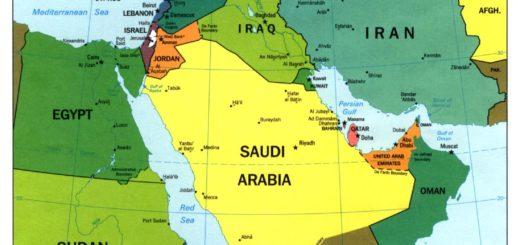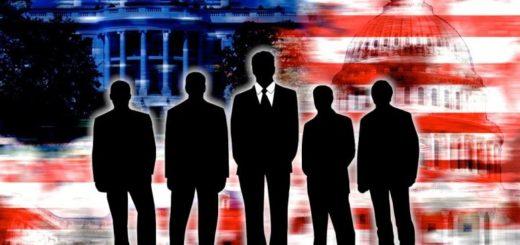EDITORIAL
How To Stop the Countdown to Nuclear War
April 17 (EIRNS)—Once again, today, a warning from experts that the United States is coming closer to nuclear war with Russia or China.
This, the front-page lead story of the Sunday New York Times, simply repeats again, quoting new nuclear arms authorities, that new, smaller and more accurate nuclear weapons and hypersonic delivery vehicles are “meant to be used.” The Obama Administration is projecting spending $1 trillion on these weapons. The commander of the U.S. Sixth Fleet admits in a CNN interview that NATO is expanding military capabilities all around Russia; including ship borne anti-ballistic missile systems just off the Russian coast. This, while both Lithuania and Poland insanely ask for the most modern U.S. nuclear weapons to be stationed permanently on their soil, immediately on Russia’s border. And while the United States injects into the South China Sea everything from U.S. and Japanese destroyers and carriers, to U.S. military drones, and projects anti-ballistic missile systems in Korea just outside Chinese territory.
Do not look for comforting explanations for the repeated warnings from Russian military planes against U.S. destroyers and aircraft along their coast. Obama is pushing for capitulation to geopolitical threats and encirclement—or for war, which will be thermonuclear war.
We are in a very late state of nuclear countdown, which cannot last much longer.
Why and how can Obama do this?
Because the tremendous worldwide economic growth and potential progress represented by China’s “New Silk Road” global infrastructure development, is seen as a mortal threat by Wall Street and the City of London, whose financial powers are bankrupt and loaded with defaulting debt. So, too, Russia’s Vladimir Putin’s strategic moves to end the endless Mideast wars, threaten Wall Street and London. They can lead to that “New Silk Road” being extended through the Mideast and North Africa in a “New Marshall Plan” of infrastructure building developed by the BRICS nations.
The Sixth Fleet’s Adm. Mark Ferguson spoke to CNN of NATO’s military capacity being “a very visceral threat to Russia”; but the “New Silk Road” development, not to speak of the deep space “great projects” being projected by China and India, are indeed seen as a visceral threat by the failing trans-Atlantic banking powers.
And the Wall Street and London powers, in their collapse, still control Obama; and still own Hillary Clinton, as richly shown, among other examples, in her 2013 gold-plated speech to Goldman Sachs.
The only way to stop the countdown to nuclear war, then, is clear. Get Obama out of office, and join in making the new economic development era represented by the mutual-benefits policy of the “New Silk Road.” Join the deep-space exploration frontier by reviving the NASA missions Obama cancelled.
The alternatives you have to choose from, are those of human life itself.
STRATEGIC WAR DANGER
United States, Russia, China In Dangerous Nuclear Arms Race
April 17 (EIRNS)—The danger of nuclear war made it to the headlines of the Sunday New York Times, today, which opens up reporting that the United States, Russia and China are all “aggressively” pursuing a new generation of smaller, less destructive nuclear weapons. “The buildups threaten to revive a Cold War-era arms race and unsettle the balance of destructive force among nations that has kept the nuclear peace for more than a half-century.” What’s at risk, according to theTimes, is that the balance of mutual assured destruction (MAD) is being upset by the development of new, more usable warheads, and new means, such as hypersonic vehicles, to deliver them.
Both China and Russia are developing missiles with smaller warheads, China and the United States are working hypersonic vehicles (so is Russia, but the Times misses this), and the United States, of course, has an entire $1 trillion program to overhaul its entire nuclear arsenal, including with smaller, more usable bombs such as the B61-12 nuclear gravity bomb. “We are witnessing the opening salvos of an arms race,” James M. Acton, a senior analyst at the Carnegie Endowment for International Peace, told a Congressional Commission last year.
MAD, the Times declares, worked, whereas, now, “the concern is that the precision and less-destructive nature of these new weapons raise the temptation to use them.” President Obama has supposedly spoken to the question that America’s planned upgrades to its nuclear arsenal are helping to drive this competition.
The Times’ report is that China is responding to the U.S. program. “No major nuclear power is more threatened by the American advances than China, analysts say.” One of those analysts is Christopher P. Twomey, a national security expert at the Naval Postgraduate School, who told the same Congressional commission that Beijing felt increasingly encircled. It sees Washington’s hypersonic glider as a way to attack China without crossing the nuclear threshold, complicating its assessment of nuclear retaliation. He added that Beijing views Washington’s nuclear modernization “with much trepidation.” Specifically, he cited plans for the B61-12 (the planned production run for the B61-12 is 400-500 bombs, only 200 of which are to be stationed in Europe, leaving plenty left over for other targets, including China if the United States makes that decision), and the advanced cruise missile, as well as new delivery systems.
“ ‘Beijing has responded to these changes,’ Twomey testified, ‘and will likely continue to do so over the next decade.’ ” The Chinese have even indicated that they want to upgrade their early warning systems, leading them closer to a launch-on-warning stance.
Another U.S.-Russian Aircraft Encounter Over the Baltic Sea
April 17 (EIRNS)—According to news reports breaking overnight, there was another U.S.-Russian military encounter in the Baltic Sea, this time in the air at high altitude, when a Russian Su-27 fighter jet supposedly did a barrel roll over a U.S. RC-135 reconnaissance jet.
The U.S. aircraft was “intercepted by a Russian SU-27 in an unsafe and unprofessional manner,” complained U.S. European Command spokesman Capt. Danny Hernandez. “The unsafe and unprofessional actions of a single pilot have the potential to unnecessarily escalated tensions between countries,” said Hernandez, who added that the U.S. is protesting the incident with the Russian government.
In Moscow, Russian Defense Ministry spokesman Maj. Gen. Igor Konashenkov dismissed the U.S. complaint. “On April 14, air defense forces detected over the Baltic ocean an unidentified aerial target rapidity approaching the Russian border. An Su-27 fighter jet was deployed by the Baltic Fleet to identify the target,” he said. “The flight of the Russian plane was in accordance with international standards for the use of airspace. No emergency situation occurred.”
To those who might think that U.S. reconnaissance flights off Russia’s borders are justified, Russian President Vladimir Putin already answered that question in December 2014, in an exchange with BBC journalist John Simpson. Simpson had pompously asked Putin to admit to Russian aggression in Ukraine and elsewhere, during Putin’s end-of-year press conference, and Putin replied by pointing out that Russia had ended flights by what he called “geostrategic aviation”—near the borders of countries outside of Russia’s near-abroad—in the 1990s, but the United States never did. Putin pointed out that Russia had only two military bases outside the country at that time, while the U.S. has hundreds. Russia’s defense budget was only about $50 billion, whereas the U.S. defense budget was in the neighborhood of $575 billion. NATO is moving bases closer to Russia, not the other way around. “And you’re telling me we are pursuing an aggressive policy? Is there any common sense in this?”
U.S. POLITICAL AND ECONOMIC
Saudis Are Threatening, But It’s Obama Covering for British-Saudi Use of Terrorism
April 17 (EIRNS)—The years-long campaign to expose the Saudi monarchy’s and Prince Bandar’s direct involvement in the September 11, 2001 attacks, in which EIR News Service and LaRouche PAC have collaborated with the 9/11 victims’ families and with members of the House and Senate, has reached a new turning point. The international political heat is now directly on Barack Obama, who travels to Saudi Arabia on April 20.
The national exposure of the Saudi Kingdom’s now-presumptive role in the 9/11 “al-Qaeda” attacks on the United States, has fully broken out of containment and was debated on all the Sunday morning TV network talk shows today, as well as making the front-page news for Britain’s Sunday Mail, Sunday Mirror, and Independent. Given especially the wild threat by Saudi Foreign Minister Jubeir to sell off all their U.S. Treasury holdings if the monarchy is opened up to exposure in U.S. courts, President Obama’s visits this week to the royal families in Riyadh and London are going to be extremely tense. The Saudi monarchy denounced with similar anger the April 10 CBS News “60 Minutes” program on the secret “28 pages” of the Congressional investigation’s report on 9/11, which essentially settled the issue: Those pages will reveal Saudi involvement in the attacks, if they are declassified.
But as furious as the Saudi monarchy is, the newly aroused mobilization for justice and truth in these 3,000 terrorist murders, is focussing on Obama. Former Sen. Bob Graham, who chaired the Joint Congressional Inquiry, was interviewed in today’s New York Daily News, and called Obama’s coverup more reprehensible than the Saudi threats. Today’s Sunday Mail, typical of London coverage, is headlined: “Victims of 9/11 Families Accuse Obama of ‘Siding with Saudi Arabia Over Its Own Citizens.’ ” The Daily News front-page combined the interesting headline “Saudi Scum” with a picture of Obama being draped with a gold medallion award by the late Saudi King Abdullah.
Most notable is the article in the Sunday New York Post, based on intelligence sources, which states: “The Kingdom’s involvement was deliberately covered up at the highest levels of our government. And the coverup goes beyond locking up 28 pages of the Saudi report in a vault in the U.S. Capitol basement. Investigations were throttled. Co-conspirators were let off the hook.”
The article, by Paul Sperry of the Hoover Institution, continues, “Case agents I’ve interviewed at the Joint Terrorism Task Forces in Washington and San Diego … as well as detectives at the Fairfax County (Va.) Police Department who also investigated several 9/11 leads, say virtually every road led back to the Saudi Embassy in Washington, as well as the Saudi Consulate in Los Angeles.” But the FBI headquarters continually called them off. Former FBI agent John Guandolo, who worked 9/11 and al-Qaeda cases out of the FBI’s Washington field office, is quoted: “The Saudi ambassador [Prince Bandar] funded two of the 9/11 hijackers through a third party. He should be treated as a terrorist suspect, as should other members of the Saudi elite class who the U.S. government knows are currently funding the global jihad. But Bandar held sway over the FBI.”
There is more in Sperry’s article, “How U.S. Covered Up Saudi Role in 9/11.”
But it should not be forgotten that Lyndon LaRouche, the only leading political figure being interviewed live on radio when the 9/11 attacks hit, immediately warned against the “bin Laden did it” line, and said that governments were involved including operations penetrating the U.S. government of George W. Bush. LaRouche had forecast eight months earlier, a “Reichstag Fire” type of attack shortly after Bush and Cheney took office.
Saudi Treasury Holdings Are Also Kept Secret!
April 17 (EIRNS)—Even the Treasury securities holdings the Saudi monarchy is using to threaten the U.S. Congress to prevent exposure and responsibility for their role in the 9/11 attacks, are kept a secret by the United States.
The Treasury has kept Saudi holdings secret for 40 years, as a concession to the House of Saud, while publishing the holdings of every other country in detail. Bloomberg News reported this on Jan. 21 in an article focussing on whether and how much Saudi Arabia might have to sell off to raise cash for its financial crisis. Now, it means that members of the Senate don’t really know what Saudi Arabia is threatening them with if they pass the JASTA Bill (Justice Against Sponsors of Terrorism Act) of Senators Schumer and Cornyn, which has strong backing from the families of 9/11 victims. Only the Saudi monarchy and a small handful of Treasury officials know the holdings.
The New York Times, in its April 16 story breaking the news that Saudi Foreign Minister Jubeir had threatened Congress with selling off the Kingdom’s U.S. Treasuries, was only guestimating that the sell-off threat involves “up to $750 billion.” As Bloomberg reported, “How much of America’s debt does Saudi Arabia own? … Now that question—unanswered since the 1970s, under an unusual blackout by the U.S. Treasury Department—has come to the fore….
“As a matter of policy, the Treasury has never disclosed the holdings of Saudi Arabia, long a key ally in the volatile Middle East…. For more than a hundred other countries, from China to the Vatican, the Treasury provides a detailed breakdown of how much U.S. debt each holds.”
Former Sen. Bob Graham, in a New York Daily News interview April 17, said “I think the action by Saudi Arabia is reprehensible and also very revealing. They are so fearful of what would emerge if there were to be a full trial [on the victims’ families’ lawsuit]. That says something about Saudi Arabia’s involvement in 9/11.”
Graham also strongly criticized Obama’s backing the Saudis. “I think it’s even more objectionable,” he said, “that the U.S. government has been supporting Saudi Arabia and erecting roadblocks to the passage of the legislation.”
Sanders and Clinton Waver on Senate Bill Threatened by Saudis
April 17 (EIRNS)—Host George Stephanopoulos of ABC News Sunday morning program “This Week” asked by Bernie Sanders and Hillary Clinton whether they backed the Schumer-Cornyn “JASTA Bill” in the Senate, the subject of the wild Saudi threat on April 14, to sell off all their U.S. Treasury holdings. JASTA would remove Saudi sovereign immunity from suits involving direct attacks on U.S. soil.
Both candidates waffled, in different ways. Sanders said he wasn’t at all familiar with the bill—which has been quite well known in the Senate—and wouldn’t take a position. Clinton give an extended response about how she never supports legislation without thoroughly studying its consequences, a sign of her responsibility, etc., and thus declined to support or oppose the JASTA Bill. “I don’t really know about that, George. I’ll have to look into it,” Clinton said.
Curiously, though, Clinton’s campaign then almost immediately sent ABC News a statement endorsing the legislation. It is posted on ABC News’ website:
“Email
“In a break with the Obama administration, Hillary Clinton has come out in support of the Justice Against Sponsors of Terrorism Act, which would allow families of 9/11 victims to sue foreign sponsors of terrorism in federal court, her spokesman Nick Merrill said today.
“New York Sen. Chuck Schumer is pushing for the legislation, while the Obama administration has been lobbying to block the bill.”
COLLAPSING WESTERN FINANCIAL SYSTEM
Flood of Corporate Defaults in U.S. and Europe
April 17 (EIRNS)—The Financial Times reported in a front-page story this morning that corporate defaults worldwide this year are already at $50 billion. The paper reported that five significant new defaults occurred in the week just ended, including those of two more U.S. shale oil/gas producers.
The only comparable or higher rate in the 21st century developed in 2009, a year of general economic collapse and mass unemployment throughout the trans-Atlantic region after the bank panic of late 2008. There were $60 billion defaults in the first four months of that year.
The corporate defaults are overwhelmingly in the trans-Atlantic countries, and predominantly related to commodity price collapses.
Clinton’s Wall Street Talks: ‘She Sounded Like a Goldman Managing Director’
April 17 (EIRNS)—The Huffington Post on April 15 published an enlightening compilation of what is known about Hillary Clinton’s much-discussed $250,000 speeches at Goldman Sachs on Wall Street in 2013, headlined, “Release of Clinton’s Wall Street Speeches Could End Her Candidacy for President.” The quotes and paraphrases from attendees (links are given for each) make quite clear why Clinton has fought so hard not to have to disclose its contents.
Goldman Sachs Employee #1 (present at one of the speeches): “[The speech] was pretty glowing about [Goldman Sachs]. It’s so far from what she sounds like as a candidate now. It was like a rah-rah speech. She sounded more like a Goldman Sachs managing director.”
Goldman Sachs Employee #2 (present at one of the speeches):
“In this environment, [what she said to us at Goldman Sachs] could be made to look really bad.”
Goldman Sachs Executive #1 (present at one of the speeches):
“Mrs. Clinton didn’t single out bankers or any other group for causing the 2008 financial crisis. Instead, she effectively said, ‘We’re all in this together, we’ve got to find our way out of it together.’ ”
Paraphrase of several attendees’ accounts from the Wall Street Journal:
“She didn’t often talk about the financial crisis, but when she did, she almost always struck an amicable tone. In some cases, she thanked the audience for what they had done for the country. One attendee said the warmth with which Mrs. Clinton greeted guests bordered on gushy. She spoke sympathetically about the financial industry.”
Goldman Sachs Employee #3 (present at one of the speeches):
“It was like, Here’s someone who doesn’t want to vilify us but wants to get business back in the game. Like, maybe here’s someone who can lead us out of the wilderness.”
Paraphrase of Several Attendees Accounts From Politico:
“Clinton offered a message that the collected plutocrats found reassuring, declaring that the banker-bashing so popular within both political parties was unproductive and indeed foolish. Striking a soothing note on the global financial crisis, she told the audience, ‘We all got into this mess together, and were all going to have to work together to get out of it.’ ”
THE NEW GLOBAL ECONOMIC ORDER
China’s ‘Win-Win’ Economic Outlook Presented to French Elite
April 17 (EIRNS)—An interesting presentation on China’s New Silk Road policy of international economic development was made to the French Institute of International Relations by Chinese State Councillor Yang Jiechi on April 14.
Speaking on “China’s Development and China-Europe Relations,” Yang noted the obvious great interest in Europe in the Chinese economy now. “What is the real picture then?” he said. “Let me share with you one latest figure released by China’s National Bureau of Statistics early this month. China’s PMI in the month of March rose above 50%, the departure point between expansion and contraction. And in recent months, investment in fixed assets has rebounded, the housing market has picked up, and the economy as a whole has regained its momentum of growth. The Chinese economy, however, still faces a downward [global] pressure. People with an objective and comprehensive perspective will see that as an anchor and a source of growth for the world economy, the Chinese economy will continue to inject positive energy to the global economic growth.”
Yang presented important prospective figures. “In the next five years, China will import goods worth over $10 trillion and make outbound investment of over $600 billion. … Inspired by the government’s call of ‘mass entrepreneurship and innovation,’ 12,000 new businesses get registered every day…. Fifty million new jobs will be added, ensuring adequate employment despite a moderated growth rate. This illustrates the immense room for growth in China’s infrastructure and services sectors.”
While repeatedly citing joint nuclear power development with Europe, and stressing China’s newly developed third-generation reactor, Yang returned to the broader basis of China’s policy. “China advocates a new type of international relationship centered on win-win cooperation,” he said, “in which countries seek to advance common development through joint efforts. To that end, China has proposed a Silk Road Economic Belt and a 21st Century Maritime Silk Road. Under this initiative, we intend to promote international industrial capacity cooperation; deepen all-around, win-win cooperation with other countries in economy, trade, investment, industry and infrastructure; help the countries involved build capacity for self-development; and create more development opportunities for more countries. We have signed intergovernmental agreements for cooperation on the Belt and Road with over 30 countries, including some European countries.”












